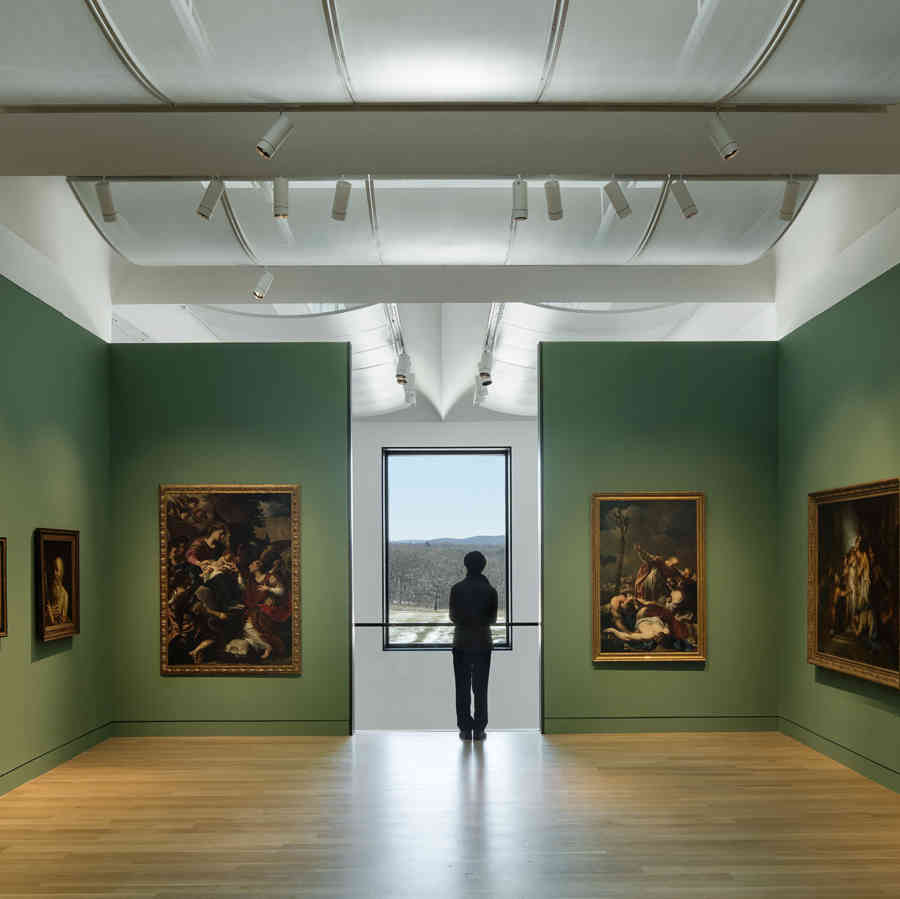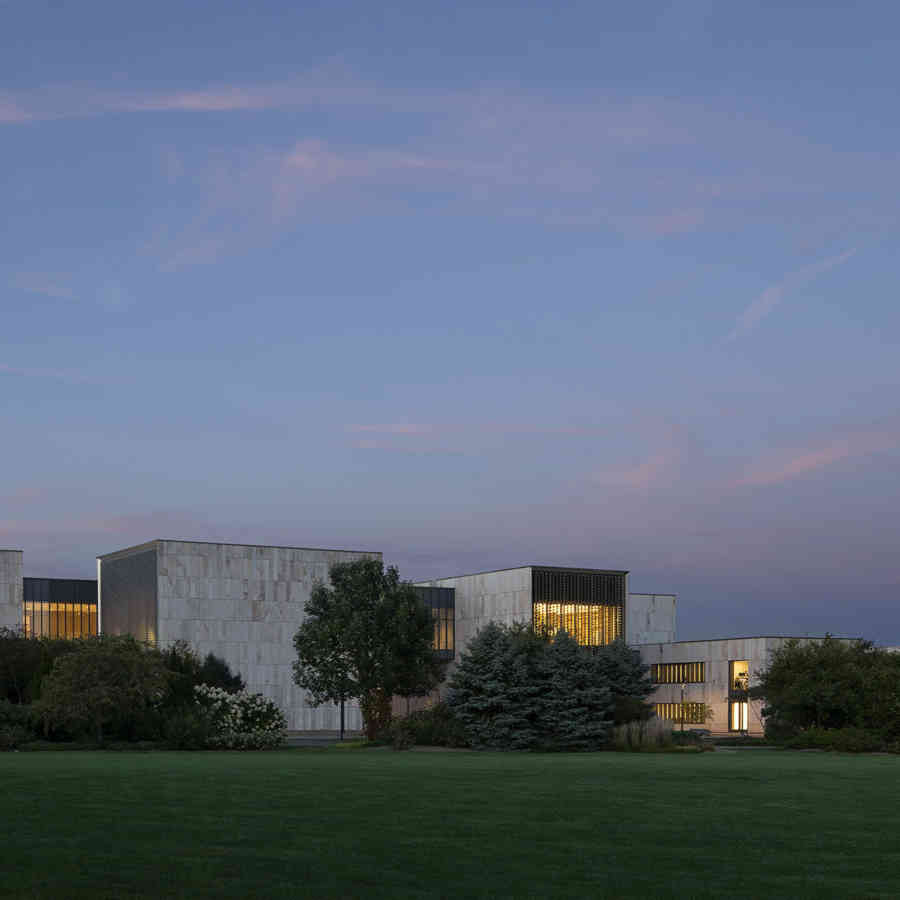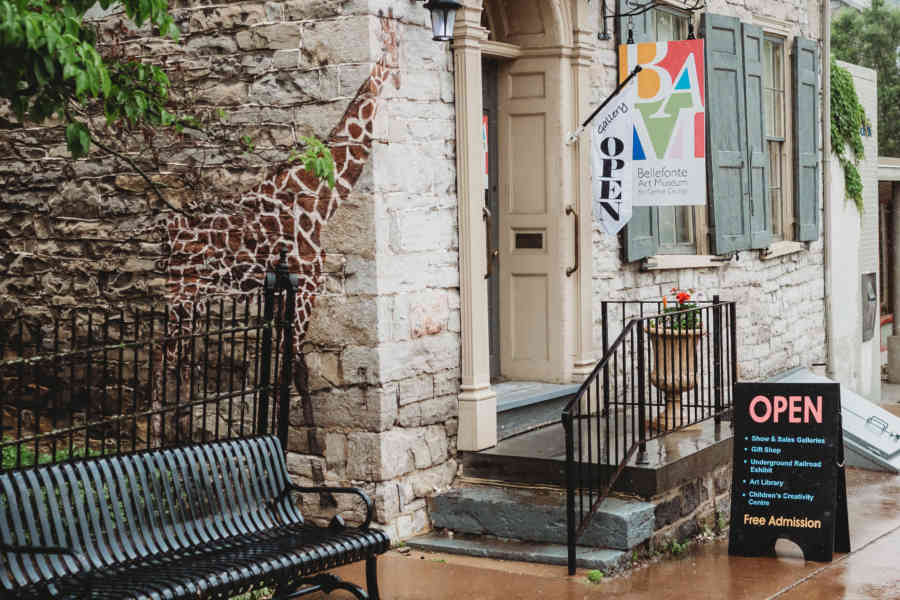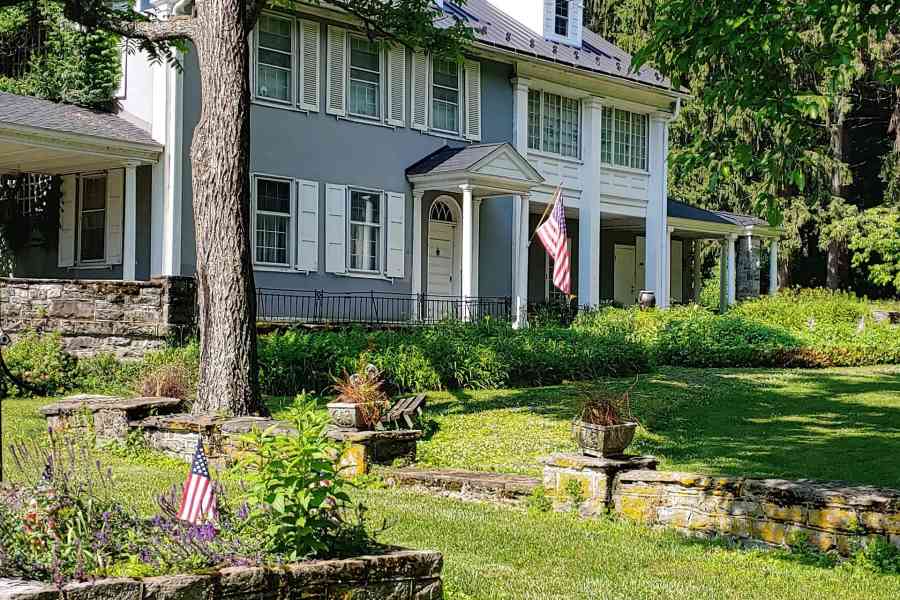Palmer Museum of Art’s new building pairs art and nature
‘MADE in PA’ exhibition, new acquisitions and community events anchor the June 1 opening of the new 73,000-square-foot museum building
UNIVERSITY PARK, Pa. — The Palmer Museum of Art’s new 73,000-square-foot building opens to visitors on June 1. The state-of-the-art facility, located within The Arboretum at Penn State, boasts unique design elements that bring the outside in, fostering a sense of connection with the landscape and inspiring visitors to reflect on the relationship between art and nature. Designed by Allied Works, the new building nearly doubles the Palmer’s footprint and includes 20 light-filled galleries, new educational and event spaces, a museum store and café, a sculpture path and outdoor terraces.

View of the Gallery of European Art at the Palmer Museum of Art at Penn State with view of the Arboretum.
- Photo taken by Jeremy Bittermann/JSBA
UNIVERSITY PARK, Pa. — The Palmer Museum of Art’s new 73,000-square-foot building opens to visitors on June 1. The state-of-the-art facility, located within The Arboretum at Penn State, boasts unique design elements that bring the outside in, fostering a sense of connection with the landscape and inspiring visitors to reflect on the relationship between art and nature. Designed by Allied Works, the new building nearly doubles the Palmer’s footprint and includes 20 light-filled galleries, new educational and event spaces, a museum store and café, a sculpture path and outdoor terraces.
“A visit to the new Palmer Museum provides a remarkable opportunity to meander through spaces filled with works of art as though one were strolling through the landscape, experiencing art, architecture and nature as something both intimate and immense,” said Erin M. Coe, the Palmer Museum of Art’s director. “Enhanced accessibility to the Museum’s collection and other new amenities, such as educational and events spaces, elevate those experiences further. It is my hope that visitors will not discern a separation between the architecture that contains these spaces and the outside landscape, but rather conceive of both as one.”
The 5-acre landscape designed by Reed Hilderbrand welcomes visitors as they approach the new Palmer. Allied Works’ innovative and versatile design for the Museum features a series of interlocking pavilions clad in regional sandstone, interspersed with perforated stainless-steel sunscreens, lofted skylights and windows, providing visitors with framed views of the surrounding landscape as they modulate daylight. The Dr. Keiko Miwa Ross Gateway, an overhead bridge, connects the Museum’s exhibition wing to the administration/education wing and serves as a gateway to the gardens, meadows and woodlands beyond.

View of the Palmer Museum of Art at Penn State from the H.O. Smith Botanic Garden.
Photo taken by Jeremy Bittermann/JSBA
Inside, the experience with nature continues with Dale Chihuly’s “Lupine Blue Persian Wall,” a site-specific installation inspired by flowers in the Arboretum. The 13-foot artwork spans 35 feet and anchors the Museum’s feature staircase with 22 floral glass forms. The new Kish Bank and William P. Hayes Family Exploration Gallery features a plant-themed artwork creation activity that welcomes visitors to color plants that are brought to life when synthesized into a collective digital canvas. The resulting digital garden installation animates, propagates and includes a natural soundscape.
“It only takes one step into the new museum to realize the spaces were developed with the specific goals of nurturing appreciation for the landscape and facilitating connections and inquiry across disciplines,” said B. Stephen Carpenter II, Michael J. and Aimee Rusinko Kakos dean in the College of Arts and Architecture. “The Teaching Gallery, a new feature for the Museum, will enable Penn State faculty to integrate art within their curricula and create learning experiences for students in a range of disciplines across the university through these encounters with the Palmer’s impressive collection of artworks. When we call the Palmer the university art museum, we truly mean it’s for the entire university — and beyond.”
The new building’s opening also marks the debut of three exhibitions organized by the Palmer Museum of Art, headlined by “MADE in PA.” On view through Dec. 1 in the Michael J. and Aimee Rusinko Kakos Gallery and the Jason D. Kogan Gallery, this ambitious show highlights three generations of artists who are natives of Pennsylvania or built their careers in the commonwealth. The paintings, sculptures, mix-media works and installations created after 1945 address an array of themes relevant to the commonwealth’s long history of academic training and innovative artistic practice, the complicated legacies of its varied geographies and socio-political realities, and the hybrid identities and cultural exchanges through time and space that characterize the work of Pennsylvania artists today. The thematic sections include Rooted in Realism, Pennsylvania Modern, The Land and its Legacies, Pop and Politics and PA Now. The exhibition includes works by Edna Andrade, Diane Burko, Vanessa German, Keith Haring, Barkley Hendricks, Franz Kline, Jeff Koons, Roberto Lugo, Philip Pearlstein, Howardena Pindell, Andy Warhol, Holly Wilson and Andrew Wyeth.

View of the Palmer Museum of Art at Penn State from the Arboretum.
Photo taken by Jeremy Bittermann/JSBA
A companion exhibition, “MADE in PA on Paper,” will be on view in the second-level Greider Family Gallery through Sept. 8. It includes prints, drawings and watercolors that explore Penn State’s legacy as a land-grant institution and features works that celebrate the commonwealth’s beauty, natural resources and urban centers from the 18th to the 20th centuries. Works by Mary Cassatt, Charles Demuth, Allan Freelon, Riva Helfond, William Trost Richards, Dox Thrash and Benjamin West will be on view.
The new building allows Penn State to cross-departmentally foster academic collaborations and provides a valuable resource to students studying numerous fields such as art, architecture and Penn State’s Top 10-rated biological and agricultural studies programs, as exemplified by the Palmer’s first-ever gallery and classroom hybrid space dedicated to allowing Penn State faculty to incorporate art into their curriculums. The Lee and Barbara Maimon Teaching Gallery opens with “The Art of Teaching: Medical Education and the Integrated Curriculum.” The exhibition extends a partnership between the Palmer Museum and Penn State’s College of Medicine that features an integrated arts and science curriculum for medical students. The collaborative exhibition curated with faculty and students will present works from the Museum’s permanent collection that relate to core concepts in medical education and patient care, including communication, teamwork, professional identity, navigating ambiguity and death and dying.
Visits to the Palmer’s 15 permanent galleries offer encounters with selections from the Palmer’s growing collection of approximately 11,000 works of art. Inspired by the Museum’s new location at the Arboretum, the inaugural installation explores the “Roots and Renewal” of artistic lineages and legacies. The reenvisioned installation lays the groundwork for the museum’s community-centered approach to the presentation and interpretation of diverse objects. Interactive digital displays in selected galleries and surprising groupings of works interrupt traditional art historical narratives and invite visitor responses as the Palmer rethinks the ways makers have embraced, adapted and rejected aesthetic traditions.

View of one of the Benjamin and Lilliam K. Snowiss Galleries at the Palmer Museum of Art at Penn State.
Photos taken by Jeremy Bittermann/JSBA
The Museum’s holdings include American art; contemporary studio glass; ceramics from a range of global cultures and eras; African art; Asian art; European Old Master paintings and sculptures; modern and contemporary art; and drawings, prints, photographs and other works on paper. The Palmer Museum will also reveal in its inaugural year several new acquisitions by artists such as Fernando “Coco” Bedoya, Joseph Delaney, Lawrence Ferlinghetti, Rodrigo Lara, David MacDonald, Malcolm Mobutu Smith, Toshiko Takaezu, Akio Takamori, Kukuli Velarde, Patti Warashina, Purvis Young, Malcah Zeldis and Arnold Zimmerman.
The new building aligns with Penn State’s commitment to environmental sustainability. Allied Works designed the high-performance, LEED-certified building with a focus on accessibility, energy conservation and the local ecology and climate. The building design considers predominant winds, solar angles and other environmental factors to balance energy efficiency with the stringent environmental standards for a fine art museum.
“By locating the new Palmer Museum building at the Arboretum, Penn State is creating a world class cultural destination,” said Coe. “We look forward to welcoming students, faculty, staff and visitors to experience the collection, our inaugural exhibitions and the spectacular setting that inspired it all.”
"By locating the new Palmer Museum building at the Arboretum, Penn State is creating a world class cultural destination"
- Erin M. Coe, the Palmer Museum of Art’s director
A commemorative book celebrating the completion of the new building includes essays by Erin M. Coe and Allied Works principal and lead designer Brad Cloepfil along with an illustrated history of the project and photographs of the architecture, galleries, educational and public spaces and exterior landscape. The publication also recognizes the many donors who helped make the new Museum possible.
The Museum was founded in 1972 and reopened in 1993 as the Palmer Museum of Art in honor of the generous and visionary support provided by James and Barbara Palmer. Admission remains free. More than $25 million has been raised to support construction of the $85 million project. Fundraising continues to support new acquisitions, exhibitions, education programs and operations. To learn more, visit palmermuseum.psu.edu.
Read the Palmer Museum's June 1 opening the start of an exciting slate of summer programs article to learn more!


